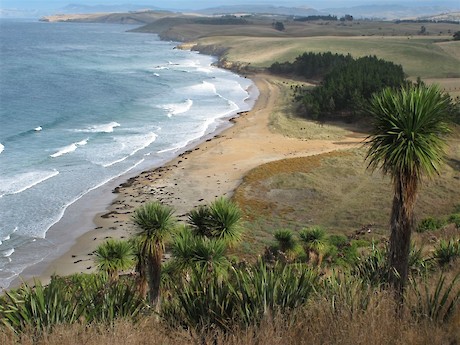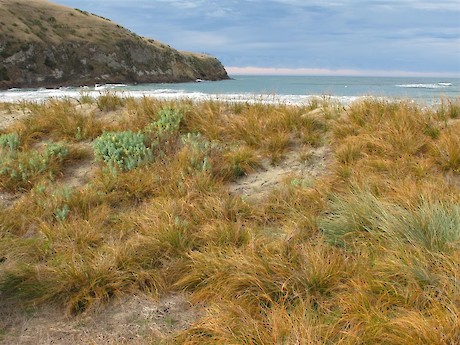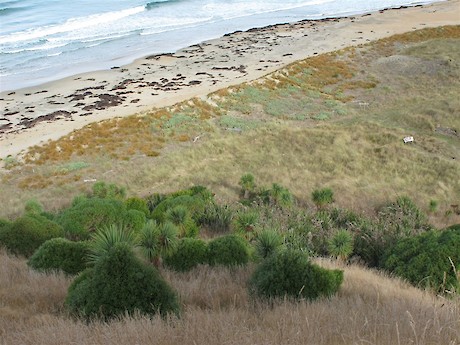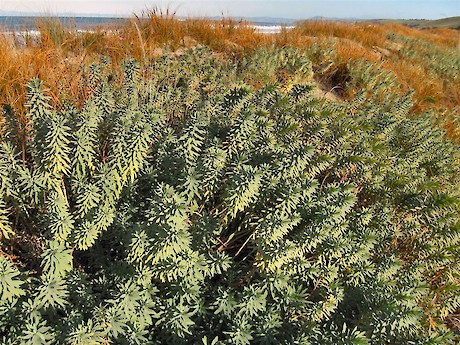 Tavora hillside plantings and restored dune: John Barkla.Tavora Reserve, about 10 minutes drive from Palmerston / 40 minutes north of Dunedin was purchased by the Yellow-eyed Penguin Trust in 1993.
Tavora hillside plantings and restored dune: John Barkla.Tavora Reserve, about 10 minutes drive from Palmerston / 40 minutes north of Dunedin was purchased by the Yellow-eyed Penguin Trust in 1993.
Comprising 40 hectares in total, 28 hectares are leased for grazing, while 12 hectares of the coastal strip and the riparian area alongside Tavora creek are managed for conservation. A Department of Conservation covenant is in place over the reserve.
While it was purchased primarily for the protection of yellow-eyed penguins, the Tavora Reserve Statement of Management Intent (1996) recognises the need to foster the conservation of other species of flora and fauna native to the area.
With regard to vegetation management, the 1996 plan had an objective to: “Re-establish and allow natural regeneration of coastal vegetation communities similar to that which previously existed in the area. These may include coastal forest, shrublands, wetlands, cliff and dune communities.”
 Shortly after the reserve was purchased restoration plantings began in the ngaio paddock at the northern end of the reserve, around the few remaining trees of the old coastal forest, such as ngaio, kowhai, narrow leaved lacebark, lowland ribbonwood and cabbage trees. Planting continues at this site, despite setbacks with frost and the ultimate aim is to extend the coastal forest from the adjacent DOC Goodwood S.R. to the sea.
Shortly after the reserve was purchased restoration plantings began in the ngaio paddock at the northern end of the reserve, around the few remaining trees of the old coastal forest, such as ngaio, kowhai, narrow leaved lacebark, lowland ribbonwood and cabbage trees. Planting continues at this site, despite setbacks with frost and the ultimate aim is to extend the coastal forest from the adjacent DOC Goodwood S.R. to the sea.
At the southern end of the reserve, a particular emphasis was on the riparian plantings beside the creek (1994-95), followed by dune restoration (beginning 2001) and a totara dune forest behind (beginning 2008).
Reference sites for the dune restoration in particular are scare in East Otago, and elements of surviving dune systems in the Catlins, and particularly Sealers Bay on Whenua Hou (Codfish Island) were used to inform the Tavora restoration.
The dune restoration has been arguably the most successful of the plantings at Tavora and certainly, when viewed from Bobby’s Head, the most colourful. As in most other eastern South Island sites the dunes were dominated by introduced marram grass, with few indigenous species present. The exceptions included the cushion plant (Scleranthus biflorus) and sand convolvulus (Calystegia soldanella).
A variety of techniques were employed to replace the marram with pingao/pikao (Ficinia spiralis), the dominant native sand binding species. These techniques included spraying with herbicide, placing carpets to suppress the marram prior to planting, mechanical removal with a tractor raking out the marram, and taking advantage in the early days of large storm events that flattened the marram dunes and covered large areas with seaweed. In new planting areas with few other desirable plants, a Roundup / Codicide herbicide mix is used. While 15 litre spray backpacks are used successfully in areas of lower marram densities, experience has shown that in dense marram a truck mounted spray unit was more effective at driving the chemical into the plants and achieving a good coverage and kill.
 Once established the pingao/pikao plantings are easily maintained with back packs or hand weeding if volunteers are available. Grass specific herbicides, such as Gallant are used, which allow quick overspraying of both the target and desirable plants. Care is taken to avoid overspray of sand tussock.
Once established the pingao/pikao plantings are easily maintained with back packs or hand weeding if volunteers are available. Grass specific herbicides, such as Gallant are used, which allow quick overspraying of both the target and desirable plants. Care is taken to avoid overspray of sand tussock.
Native sand binders and dune plants were sourced from within the ecological district if possible, but in the case of sand tussock (Poa billardierei), no sources were found locally and seed was obtained from plants at Oreti Beach in Southland.
Sand coprosma (Coprosma acerosa) was sourced from Andersons Lagoon, just north of Tavora, while Cook’s scurvy grass (Lepidium oleraceum) came from the Otago Peninsula.
 Planted Euphorbia glauca and pingao on the restored Tavora dunes: John Barkla.Sea spurge (Euphorbia glauca) was grown from cuttings sourced from Katiki Beach / North Otago.
Planted Euphorbia glauca and pingao on the restored Tavora dunes: John Barkla.Sea spurge (Euphorbia glauca) was grown from cuttings sourced from Katiki Beach / North Otago.
While debate currently swirls around the possible role of spinifex in southern South Island dune restoration, the Trust is maintaining a watching brief on trials being conducted by Dunedin City Council.
Limited room exists for further plantings of pingao, sand tussock and Euphorbia glauca, and the new emphasis will be on connecting these dune plants with the shrubby species in the back dunes and ultimately a totara community on the dune ridge.
David McFarlane
Field Manager
Yellow-eyed Penguin Trust
